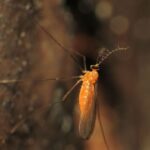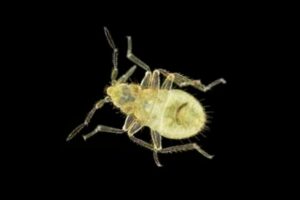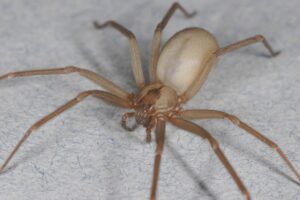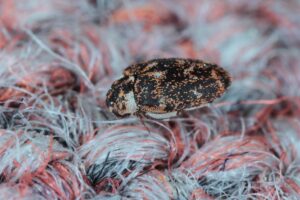You’re alone, sitting in your living room, and suddenly you notice a fly buzzing around. Before long, you have a swarm of flies buzzing around your living room. What’s going on here? Why are there so many flies in your house all of a sudden?
A housefly infestation within or close to your residence is the most common reason for houseflies swarming all over your house. A sudden swarm of small flies indicates that many eggs have already hatched and matured into adult flies. There’s a good chance the source is in your house, attic, garden, or garage.
Read on to learn how to identify the causes of your house fly infestation, the types of small flies you can find in the house, and the things can do to get rid of them for good.
What Causes Tiny Flies in the House?

A lot of flies in the house can be a real nuisance. They’re not only annoying but can also be a sign that something is happening in your home that needs to be addressed.
Sudden housefly infestations are usually the result of poor sanitation or improper food disposal. A housefly can lay its eggs in any organic matter that hasn’t been adequately cleaned up, such as:
- Food scraps left behind in your garbage or compost pile;
- Grime and dirt buildup on dishes after they’ve been washed;
- Food remains stuck on countertops, door handles, and other places where people touch it frequently;
- Dead animals and other organic matter left outside in your yard or garden; or
- Unsanitary conditions within your home (such as dirty toilets, leaky pipes, or unclean floors).
If you notice tiny flies buzzing around your house, one of these is likely causing the problem. You may need to take steps to eliminate the source of contamination and prevent further infestation. But before we get into that, it’s essential to know what you are dealing with.
6 Types of Small Flies in the House
Flies are common in almost every ecosystem, and there are over 16,000 different species in North America alone. But did you know there are different types of small flies in the house? Here are six types of small flies that might be buzzing around your home right now:
1. Fruit Flies
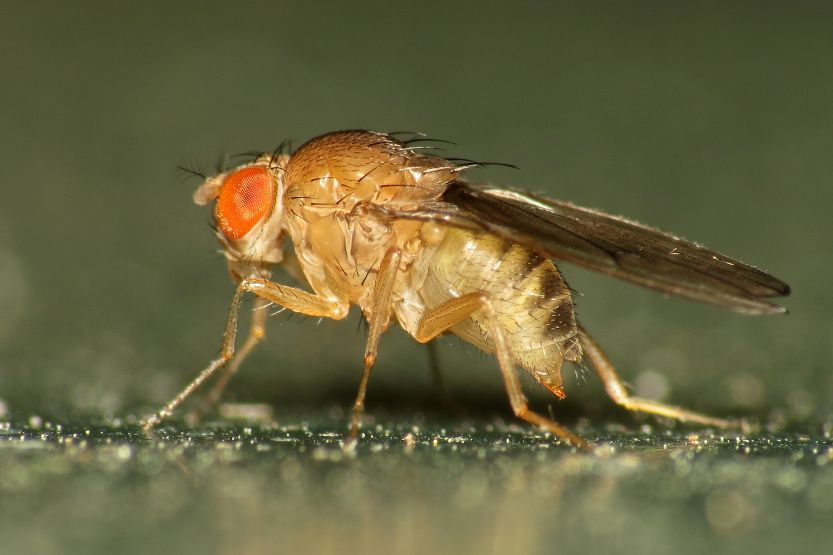
Common Household Pest
These flies are a common household pest and can be even more of a nuisance when they suddenly appear all over your house.
Size and Appearance
Adult flies measure around 1/8 of an inch in length and one of their distinguishing characteristics is their red eyes. The rear part of their body is black, while the front is tan.
Reproduction
They also lay their eggs on or very close to the surface of decaying foods or other moist organic matter. Fruit flies are incredibly capable of reproducing.
Adult female fruit flies can lay approximately 500 eggs in their brief lifetime. It only takes about a week for them to mature from eggs to adults.
What Are the Signs of a Fruit Fly Infestation?
Fruit flies are attracted to ripe or fermenting fruits and veggies. So if you find these tiny pests swarming around your home or office, it’s usually an indication that there is rotting fruit or vegetable somewhere nearby (likely in your trash bin).
Often Found in Drains or Garbage Disposals
They’re also attracted to dirty dishes, garbage disposals, and other moist food or drink spills in your home. Fruit flies are often found breeding in drains or garbage disposals that have been left open for a long time.
How to Prevent Fruit Flies
It is essential to keep your kitchen clean and dry to avoid attracting these pests. You should also empty trash cans and clean out drains regularly to ensure there aren’t any areas for them to lay their eggs.
If you notice an area with fruit flies near your kitchen sink or garbage disposal, ensure it is cleaned immediately.
2. Drain Flies

Likes to Lay Eggs in Drains
This type of fly gets its name because it likes to lay its eggs in drains, where you usually find them buzzing around — especially in warm weather when the drain covers heat up and attract insects looking for a place to lay their eggs. They are also known as:
- Sewer gnats
- Filter flies
- Moth flies
- Sink flies
Size and Appearance
Aside from a pair of wings and antennae, drain flies have six legs. An adult drain fly’s length is around 1/16 of an inch, and its body color can range from tan to light gray.
The larvae of the drain fly are about 3/8 of an inch long and do not have legs similar to worms. Its larvae are grayish with darker colors on their ends.
A drain fly’s body and wings are heavily covered with long hairs, contributing to the creature’s overall fuzzy look. Its wings are folded and held in place when resting.
May Hop on Walls
Drain flies are poor flyers, so you may see them hopping on walls, including other resting surfaces. When they fly, they only do so for a few feet at a time. So if they’re disturbed, they will fly or hop short distances. When swatted or squished, the wings of a drain fly crumble into fine dust.
General Term for Several Small Flies
In reality, “drain flies” are just a general term for several small flies, such as phorid flies, fungus gnats, and Sphaerocerid flies. These tiny flies are commonly found in drains and other wet or slimy places where they can lay their eggs.
Common Hiding Spots
During the day, adult drain flies tend to rest on:
- Walls near plumbing fixtures;
- Shady areas; and
- The sides of bathtubs and showers.
3. Phorid or Humpbacked Flies
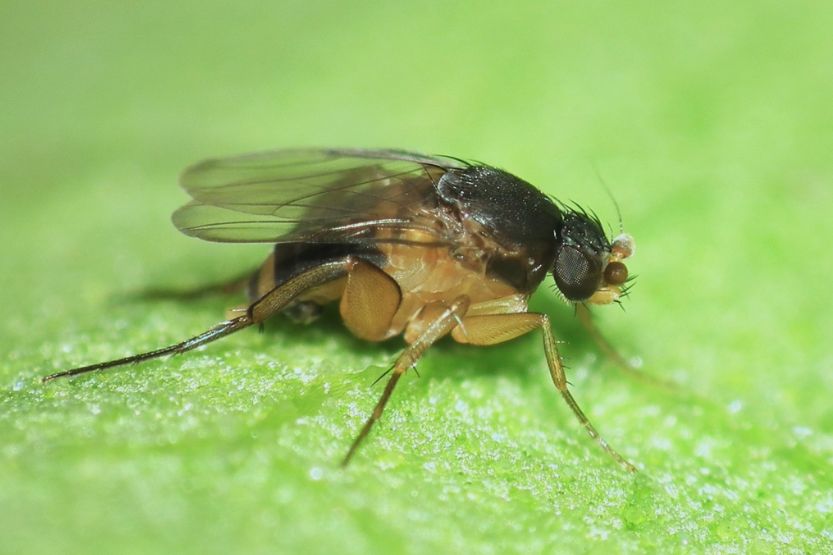
Usually Mistaken for Fruit Flies
Phorid flies are usually mistaken for fruit flies because of their similar appearance. However, their biology is quite different.
Size and Appearance
The phorid fly does not have the characteristic red eye color of the fruit fly. Phorid flies belong to the category of small flies and can reach a maximum length of up to 1/8 inch when measured from head to tail, including their wings.
Additionally, the shape of this fly’s thorax, which is humpbacked, is one of its most distinguishing characteristics. It’s called a humpbacked fly due to the pronounced arch of its thorax.
Behavior
When adult phorid flies are startled, they have a peculiar behavior of frantically dashing across surfaces rather than instantly taking flight. This is another distinguishing characteristic of this species.
Habitat
You can find phorid flies in various habitats, although they’re most populated in places with decomposing plant and animal matter. So when looking for its breeding grounds, remember that its larvae can only thrive in moist and decomposing organic matter.
These small flies prefer spots such as:
- Kitchen and bathroom drains
- Around plumbing areas
- Garbage containers and disposals
- Basements
- Crawl spaces
4. Sphaerocerid Flies

Also Known as Dung Flies
Another name for Sphaerocerid flies is small “dung flies” because they’re known to lay their eggs in animal manure. There are numerous species of these flies worldwide, with more than 200 species recorded in North America.
Commonly Found in Residential and Commercial Kitchens
The species that thrive in commercial chicken houses are the ones that are most likely to be encountered in the United States. You can find these flies in residential and commercial kitchens, where they share an environment with phorids and fruit flies.
Size and Appearance
Adult sphaerocerid flies are dark in color and about 1/8 inch long.
Habitat
Sphaerocerid flies have many different places where they grow and eat. However, most species develop in environments such as:
- Commercial chicken houses
- Animal droppings
- Cattle and horse manure
- Feed waste
- Corpses
Other species can infest almost any environment as long as there’s a source of accumulated moist organic material in certain areas, including but not limited to:
- Drains
- Cracks in homes
- Clogged plumbing lines
- Kitchen floor gaps
Again, why are there flies in my house all of a sudden? If there is a sudden appearance of small flies in your house, there are probably newly hatched eggs. Check your garage, attic, kitchen, and garden for their hiding spot.
5. Gnats
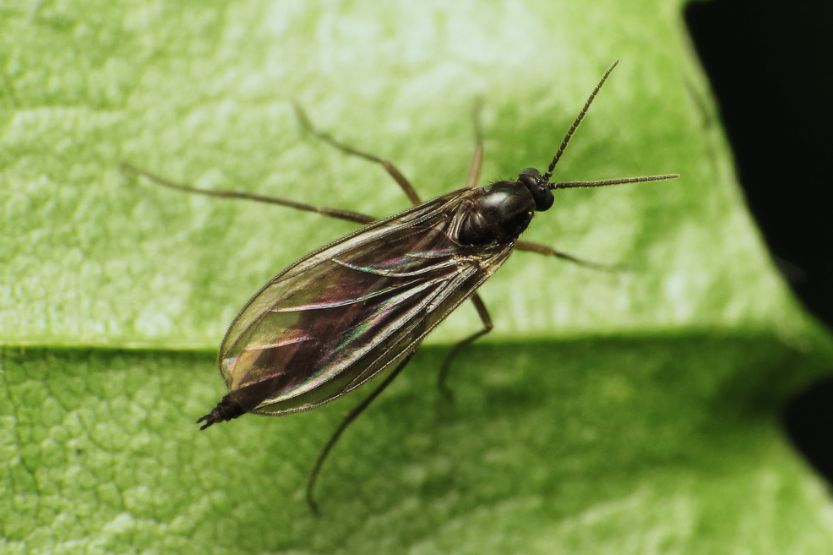
Drawn to Body Heat, Presence of Water, Etc.
Gnats are drawn to body heat, the presence of water, and the aroma of something sweet or fruity. They’re one of the most popular types of annoying flies you can find indoors and outdoors.
Refer to Small Winged Insects of the Fly Family
The term “gnat” is often used when referring to numerous small, winged insects that belong to the fly family. And despite the widespread misconception, these small flying insects referred to as “babies” are adults.
It’s possible that the small flying insects that people call “gnats” are either fungus gnats or fruit flies. Fruit flies and gnats are different.
Size and Appearance
Gnats are small flies with long legs and thin, long wings. Also, looking closely, you may see vein patterns on their wings.
Gnat eggs are almost impossible to see with their oval shape, semi-transparent, and smooth surface. And their maggots or larvae are white, with a shiny blackhead measuring up to a quarter of an inch long. Their pupae, which appear to be cocoons made of silk, can be seen in the soil.
Easily Mistaken for Other Small Flies
Gnats are frequently confused with other small flies that can be seen in and around homes. At first glance, gnats can be confused with drain flies, fruit flies, and phorid flies. However, gnats are far smaller than the other types of flies.
Identify the Fly‘s Breeding Ground
Finding the breeding ground of the fly will help you better identify the species of fly you are dealing with:
- Phorid flies and fruit flies – These flies lay their eggs on organic matter such as fruits and vegetables, including food spillage and waste.
- Drain flies – They lay their eggs in drains, sewer tanks, and soil contaminated with sewage.
In addition to breeding in drains, gnats are often sourced from fungi and potted plants.
6. Cheese Skippers
Reproduction
This fly may be found all over the United States and is a pest to meats and cheese. Adult flies feed on breeding sources’ juices, mate, and lay eggs quickly. They usually lay their eggs on top of moldy cheese or rotting meat. On average, about 140 eggs are laid on a given food source.
Size and Appearance
Cheese skippers measure around 3/16-inch long and appear shiny and black with bronze hues. Their entire body is only half the size of a typical housefly, and their eyes are reddish-brown. And when their body is at rest, they have slightly iridescent wings.
Can Transmit Diseases to Humans
Cheese skippers are capable of transmitting diseases to humans under certain breeding conditions. Both the fly and larvae breed on deteriorating organic matter. So individuals may experience intestinal irritation if they consume foods that contain the larvae of cheese skippers.
What Other Small Black Flying Insects Could be In Your House?
How to Get Rid of Flies in the House
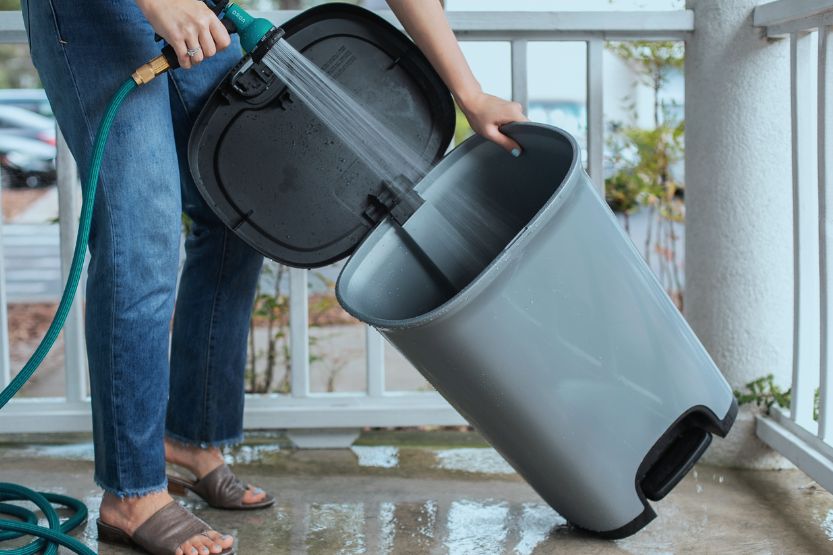
Flies seem to be multiplying faster than you can find them, and I know you want to get rid of them as soon as possible. Luckily, there are lots of ways to do just that. Below are easy ways to get rid of flies in your house for good:
1. Clean Up Food and Garbage
Flies attract decaying matter of all kinds, so if you have a lot of trash around your house, expect to have more flies buzzing around than usual. Additionally, if you have pets, ensure that their food bowls are always clean and never leave out any leftovers from meals.
2. Get Rid of Any Standing Water
Most people don’t realize that flies are attracted to water, and if you have a leaky pipe or anything similar in your house, expect an increase in their numbers. If you spot a leak, fix it immediately. Clean up spills and wipe down counters after cooking.
3. Clean Your Trash Cans Regularly
If you have garbage cans in your house, ensure they’re always clean. And if you notice that flies are buzzing around them, this is probably because they’re attracted to the odor coming from inside of them. Clean your trash cans once a week and replace their lids tightly when not in use.
4. Clean and Fill Cracks to Keep Small Flies Out
Do you have cracks in the floor or gaps between any equipment and the walls of your home? Make sure to caulk them. This is an easy way to prevent flies from getting into your house. Drying off moist places is also essential because larvae can only survive in a humid environment.
5. Store Food Properly
If you’re planning on eating leftovers, make sure that they’re stored correctly in a way that will prevent flies from getting into them. This can be as simple as throwing away any meat left out overnight.
Make sure to refrigerate all foods after cooking them, and don’t leave food on the counter for long periods if flies are buzzing around your house.
How to Get Rid of Flies Naturally
If you don’t have any fly repellent in your home and don’t want to use chemicals, there are some natural ways to keep flies away:
1. Use Herbs and Flowers
Some herbs and flowers give off scents that repel insects, including flies. Consider planting herbs and flowers near windows or doors where you often see flies buzzing around. These plants include:
- Rosemary
- Lavender
- Marigold
- Catnip
- Basil
- Bay leaves
2. Use Venus Flytrap
Carnivorous plants like the Venus flytrap lure and eat insects, including flies. They’re moderately easy to grow and can be placed near windows, doors, or other areas where you see flies buzzing around.
3. Water and Cayenne Pepper Spray
Cayenne pepper is effective at warding off house flies. Mix water and cayenne pepper and spray the mixture around the house to prevent flies from entering your home.
4. Dish Soap and Apple Cider Vinegar
You can catch flies with apple cider vinegar and dish soap solution. Here are the instructions for this method:
- Fill a tall glass with about an inch of apple cider vinegar, and then add a few drops of dish soap.
- Put a plastic wrap around the glass and use rubber bands to secure it.
- Punch several holes on top of the plastic wrap.
Flies will be drawn to the vinegar in the glass, and as a result, they’ll enter through the holes. However, flies won’t land on the vinegar but sink to the bottom of the container.
Frequently Asked Questions – Small Black Flies in the House All of a Sudden
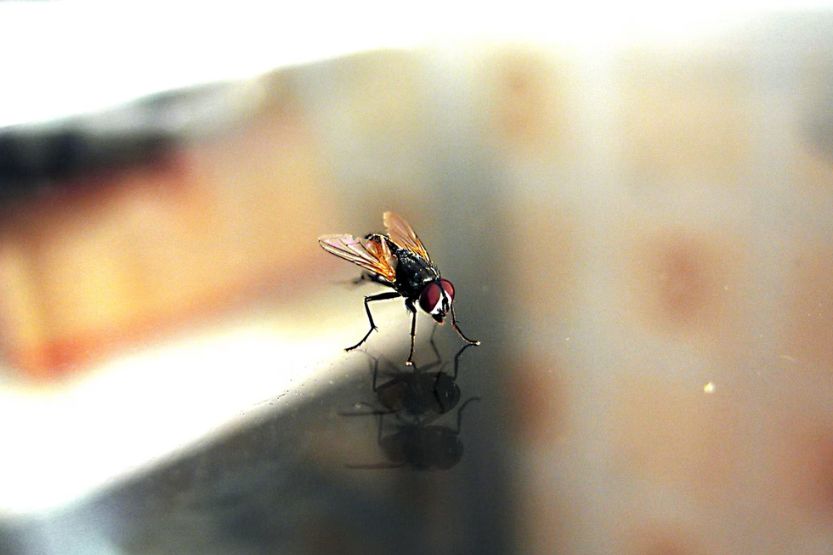
Why Are There Many Flies in My House All of a Sudden?
The main reason behind this is that flies can rapidly reproduce within a short time. The average lifespan of a fly is somewhere between 15 and 30 days. However, this can differ depending on several factors, including the species, the conditions of its surroundings, and food accessibility.
What Causes Small Flies in House?
Small flies tend to breed on moist organic material, usually in locations such as garbage, rotting fruit or vegetables, and soil contaminated by drainage or sewage.
How Do You Find the Source of a Fly Infestation?
Houseflies are most commonly found in areas that have both light and water. You’ll be able to spot signs of an infestation if you look in these locations.
Houseflies usually gather in large numbers in areas such as gutters, light fixtures, mulch piles, and garbage cans. In addition to this, they take pleasure in food sources, particularly those that are decomposing.
How Do Flies Get in the House When Windows Are Closed?
Small house flies typically enter a home through cracks or openings. These include foundation cracks, gaps around plumbing and pipes, vents, holes in the air conditioner filter or cracks around the AC unit, cracked ceilings, and holes in the roof.
What’s the Difference Between House Flies and Cluster Flies?
Cluster flies have a length of about 7 mm, whereas house flies only measure between 3 and 6 mm. The body of a cluster fly is dark with a silver checkered pattern. House flies that infest homes have a dark gray appearance and typically have four thin black stripes running down their bodies.
Conclusion – House Suddenly Infested with Small Flies
Small flies can appear in your house anytime, so it’s essential to know the causes of infestation and how to get rid of them. The best thing you can do is keep your home clean and tidy and ensure that there are no food or water sources where they can breed.
But if the problem persists, it could indicate that you have a bigger problem. If this sounds like too much work, it’s time to hire an exterminator to come out and take care of the problem for you!

